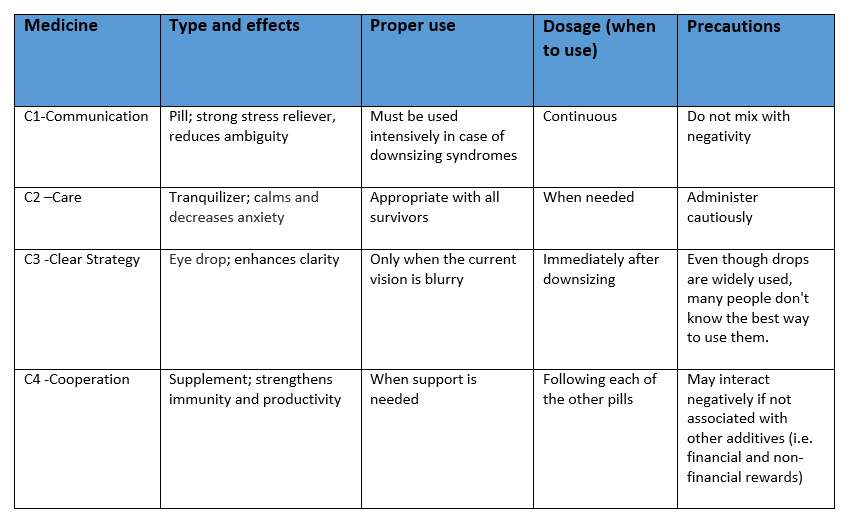The Aftermath of Downsizing

Workforce downsizing has spread and become a worldwide phenomenon affecting not only developed countries but also the rest of the world. The effects of downsizing on surviving employees include low morale, high job insecurity, low job satisfaction and high turnover.
With all the uncertainties caused by today’s restructuring, downsizing and outsourcing trends, employees have started looking at their relationship with their employers with suspicion.
The basic psychological contract between employee and employer asserts that employees can expect job security in return for hard work and loyalty. Even if they survive the downsizing onslaught, survivors will feel that the basic psychological contract was violated and their trust in their employer will be shaken, leading to a serious drop in employee commitment and loyalty.
Another problem with potentially serious consequences is the high turnover rate of top performers that organizations will experience for months after a downsizing program ends. These disappointed employees would have been the managers and leaders of tomorrow, and losing them means the organization will have to replace them. Retention cost of top performers is significantly lower than the costs of hiring and training the large number of new employees needed to uncover, among them, the new leaders of the future. When taking the decision to downsize, the organization must be aware of this fact.
In addition to the above, there is a tendency for managers to feel that employees who remain in their jobs are lucky. Managers therefore feel justified to flood the survivors with additional work without considering the high probability of mistakes or turnover. Under such conditions survivors will remain discreet and may even work harder in the short term; but longer term, problems ranging from minor to incurable will appear.
Ironically, managers will talk less with their people in these difficult times when they actually need to communicate more. When employees’ trust has been injured, organizations must heal and managers must reassure employees about their job security and their future. In order to revitalize surviving employees and rebuild a high performance culture, leaders need to use the 4Cs: communication, care, clear vision and cooperation. (Refer to the table at the end of the article):
- Communication: leaders need to develop a communication strategy that will keep employees informed. They could create communication platforms such as employee focus groups that can discuss employee concerns and the effects of downsizing. Organizations should reinforce their open door policy and encourage managers to speak honestly with employees about possible scenarios. This transparent communication will minimize employees’ tendency to spread rumors in the workplace.
- Care: leaders need to show empathy toward the people who were let go and care for those who survived. They should try to ask the survivors to vent their feelings about the events that happened. Visibility and accessibility of management are crucial after the downsizing period. In addition, this ‘after the downsizing’ period is the best time to review the rewards program and send a strong message to the surviving employees that the organization cares about them, that they are valued and appreciated.
- Clear vision: Downsizing is generally seen as negative. In order to change this perception, leaders should have a clear vision that will allow them to properly manage the remaining resources. This clear vision will move the organization forward through the waves of uncertainty. Accepting the post-downsizing vision ensures that everyone onboard is pulling in the same direction. Survivors’ commitment to the vision will rejuvenate the organization that has been downsized.
- Cooperation: Leaders shouldn’t assume that the survivors will know how to carry out their responsibilities, particularly if some of them have to take on jobs with different skill sets that former coworkers used to do. Because downsizing is hectic for both managers and employees, cooperation, training and trust are a must to overcome the new confusing environment. Close cooperation with employees for the successful implementation of post-downsizing strategy will have a positive impact on the environment resulting in opening new doors and generating innovative ideas.
Sometimes financial realities force organizations to take cost cutting measures and reduce their workforce. Unfortunately, downsizing and layoffs have become a fact of life and a frequent organizational tactic. People have become accustomed to seeing joblessness as a necessary evil and some already expect, at some point in their career, to be victims of downsizing. Having known families, relatives, coworkers and friends who were affected by downsizing, it is not difficult for people to accept terminations as the new reality of working life.
So, if you want to take the hard decision of downsizing, my advice to you is to implement measures to reestablish confidence between the company and its survivors. Consider the new status as an opportunity and a positive change. Maintain contact with dismissed employees especially with those you would like to rehire at a later stage. To sum it up use the 4Cs.
As for you dear employee, maybe Mr. Hal Lancaster, editor, Wall Street Journal, was right when he said:"Getting fired is nature's way of telling you that you had the wrong job in the first place."
The 4Cs prescription table


Related Articles

Certified for Success: Why Global Credentials Matter More Than Ever
Let us face it: todays business world does not slow down for anyone.

Press Play to Hire - AI Video Interviews Are Changing Recruitment
Why Smart Recruiters in the GCC Are Letting Algorithms Take the First…

The Imperative of Upskilling and Reskilling
In an era of relentless technological advancement, economic volatility,…

Should HR Professionals Embrace AI Fully?
In the fast-changing tempo of businesses today, AI is no longer a thing…
